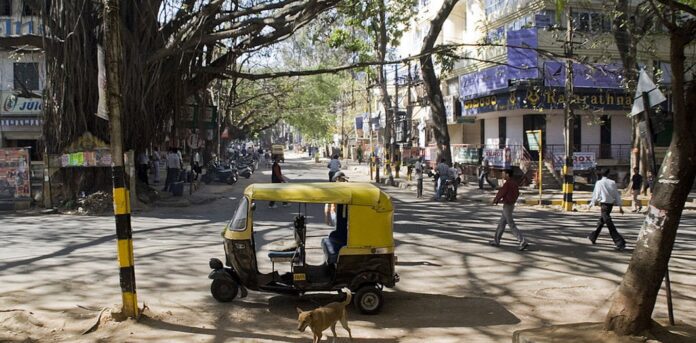We’re seemingly to mediate that nature and cities are polar opposites. But proper here is now now not staunch. As my evaluation on Bangalore or Bengaluru – India’s IT hub – reveals, for tons of of years, the inhabitants of this case grew because of nature, now now not no matter it.
In my information Nature within the Metropolis: Bengaluru within the Previous, Repeat and Future, I take a deep dive into the ecological historic previous of an Indian metropolis, going map help to this point to the sixth century CE.
Inscriptions on stone and copper plates inform that the place to begin for a brand new village was normally the arrival of a tank, or lake, to love rain water – important and existence-giving on this damaging low-rainfall surroundings.
These inscriptions current mesmerizing insights into the shut relationship that these early residents had with nature. They comment the panorama as consisting of the lakes, the encompassing irrigated and dry land, the “wells above”, and the “timber under”. This three-d watch of the panorama, consisting of two main sources, water (lake) and meals (agriculture), nourished by nature under (within the invent of wells) and above (within the invent of timber) is a remarkably holistic considered nature.
Sadly, in presently’s urbanised India, now we like misplaced all ticket of this three-d imaginative and prescient.
Declining sources of water
The central areas of Bangalore had 1960 originate wells in 1885; presently, there are fewer than 50. Bangalore moreover misplaced a bunch of its lakes, that had been considered to be filthy breeding grounds for malaria, and remodeled to bus stands, shops, housing, and a bunch of constructed areas.
Sree Kanteerava stadium was in-built 1997, the arrange Sampangi lake at probability of be positioned before.
Shakkeerpadathakayil/Wikimedia, CC BY-SA
Town’s central Sampangi lake, which provided water to many points of Bangalore within the Nineteenth century, was remodeled right into a sports activities actions stadium by the 20th century, forsaking solely a cramped pond for ceremonial spiritual functions. As long as lakes and wells provided water, important for the actions of day after day existence, they had been worshipped as sacred and secure as existence-giving.
Furneaux, JH (1895) Glimpses of India. A mighty photographic historic previous of the Land of Antiquity, the mighty Empire of the East. Historic Publishing Agency. Philadelphia.
Furneaux, Wikmedia
Rituals celebrating the overflowing of lakes all through the monsoon by paying homage to the lake goddess saved the significance of lakes within the forefront of of us’s imaginations. However as soon as piped water started to be provided within the Nineties, these water our our bodies started to decay. By the tip of the Nineteenth century, wells and lakes started to be polluted with garbage, sewage, and even corpses all through instances of epidemics and sickness.
Voters nurturing nature
What remodeled this centuries-long, strong relationship between of us and nature? When Bangalore shattered its native loop of dependence by importing water from originate air, of us forgot the significance of their native sources of water.
But, as our evaluation has proven, Bangalore mute needs water incandescent as badly for its resilience. Town has grown so gigantic that piped water from a methods away rivers can now now now not current all its needs.
Thus resurgent citizen actions throughout Bangalore like begun to level of curiosity on preserving and restoring lakes of their neighbourhoods, which is raring to moreover recharge the water under floor. In some low earnings settlements, the arrange ample water current is a hard and fast enviornment, group wells, as soon as not noted, are genuinely being assiduously secure and maintained as correctly.
The similar sample – of an early, shut relationship with nature, adopted by a destroy, and later a resurgent curiosity within the connection – is moreover collaborating in out when it comes to timber. Early residents did now now not solely level of curiosity on water, however moreover “greened” this dusty, sizzling panorama of the dry Deccan plateau. Successive rulers from the sixteenth century onwards, and outdated residents planted tons of of 1000’s of timber over centuries.
The selection of lakes in Bangalore elevated between 1791 and 1888 then diminished after piped water was launched in.
Sreerupa Sen, CC BY-NC-ND
Each settlement was greened with a gundathope – a woodlot normally planted with fruiting timber, jackfruit, mango and tamarind – which provided shade, fruits, firewood for cooking, grazing enviornment matter for cattle, and usually timber as correctly.
When one tree was chopped down, some other was planted to substantiate continuity. Current areas of city had been assiduously greened by administrators, who planted timber, and residents, who watered and cared for them, making the lots of the companies they provided. This observe of greening endured all through the British colonial size of governance, and later into the 20th century, after Indian independence. On account of of the chilly native climate of Bangalore – in piece because of its spot on a plateau, however moreover because of its lakes and timber, created, planted and nurtured by native residents and rulers over centuries – city grew to become a selected spot for the British army, and later as a science and industrial hub in south India.
It is now not any accident that Bangalore, as soon as known as India’s lake metropolis and yard metropolis, grew to become the nation’s IT capital.
Hovering temperatures and rising air air air pollution
By the gradual twentieth century, this relationship had begun to fray. With fast inform, roads and a bunch of constructed infrastructure received significance within the minds of planners. As a consequence, timber had been handed over, and felled of their 1000’s for style initiatives in Bangalore.
Inevitably, with extra private autos on the street, and fewer timber, city grew to become hotter, and the air severely polluted. Voters shortly realised this connection. So did lecturers. Our evaluation as an illustration demonstrated that timber chilly the air by 3 to fiveºC, and carve the temperature of the street flooring by as mighty as 23ºC, as nicely to drastically reducing air air air pollution.
Social media to the rescue
But citizen actions did now now not proceed. Within the early twenty first century, the nonagerian Honnamma Govindayya has grew to become an epitome of struggles to defend Bangalore’s surroundings.
Honamma Govindayya.
Harini Nagendra, CC BY-NC-ND
She fought towards staunch property builders who desired to remodel an enviornment park that her kids performed in, taking a case all the best way to the Supreme Courtroom of India. She received and saved a cramped however important patch of inexperienced from destruction.
Mass citizen protests presently like endured and received needed victories for city’s inexperienced quilt, alongside with the reversal of a controversial determination to manufacture a steel flyover, which might possibly possibly like destroyed 1000’s of timber.
Today these actions are strongly supported by social media. Within the flyover case, the twitter ticket #steelflyoverbeda (“beda” which system “no” within the native language, Kannada) went viral, attracting a lot of of followers.
Social media has provided a extra shimmering map for as soon as remoted teams of of us to hitch and coordinate, and usually to ratchet up public stress on nature-blind administrators. Who is aware of what variety of would favor supported Honamma Govindayya if she had a Twitter narrative then?
Understanding the traditional previous of nature reveals a genuinely a bunch of picture from the preconceived thought that, on the least in international locations love India, the arrange the pressures of style and inform are so gigantic, nature and cities can not coexist.
Today, this attitude on the ecological historic previous of Bangalore can support city-dwellers worldwide signal why nature on the town is now now not incandescent essential for the metropolis’s previous, however moreover important for its resilient future.
A historic previous of resilience, Harini Nagendra.

